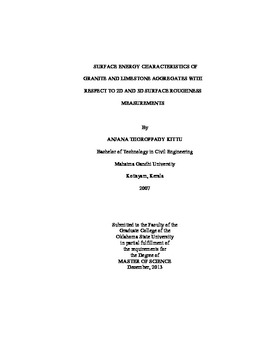| dc.contributor.advisor | Bulut, Rifat | |
| dc.contributor.author | Thoroppady Kittu, Anjana | |
| dc.date.accessioned | 2015-06-17T20:08:15Z | |
| dc.date.available | 2015-06-17T20:08:15Z | |
| dc.date.issued | 2013-12-01 | |
| dc.identifier.uri | https://hdl.handle.net/11244/15147 | |
| dc.description.abstract | Surface energy properties of aggregates and asphalt binders can be used to select appropriate aggregate and asphalt binder combinations for the construction of moisture durable pavements. Sessile drop device is an effective method to determine the surface properties of aggregates and asphalt binders by performing direct contact angle measurements. However, the variations in surface roughness could impact the contact angle formed on the aggregate surface. Therefore, the present study was intended to evaluate the contact angle measurements on aggregate surfaces at different levels of surface roughness using the sessile drop device. Large size granite and limestone rock specimens were obtained and cut into appropriate sizes to create flat surfaces for contact angle measurements. The samples were subjected to a series of polishing stages using different particle sizes of silicon carbide and aluminum oxide grits. Contact angle measurements were subsequently conducted using three probe liquids on the unpolished surface as well as on the specimens subjected to different levels of polishing. Surface roughness measurements were also performed after each polishing stage using a two-dimensional profilometer and a three dimensional optical profilometer. The surface roughness decreased as the polishing progressed. The results from this study showed that as the surface became smoother, the values of contact angles formed by the probe liquids decreased, and attained consistent values after polishing with silicon carbide 1000 grit. The surface energy components also showed consistent results from the silicon carbide 1000 polishing stage onwards. Present results imply that initial polishing of aggregate surface is required to obtain consistent results from the sessile drop device. Correlation between two methods of measurements of surface roughness indicates that both methods could be useful for measurement of rock samples. Once the surface roughness is standardized to obtain representative contact angle, the sessile drop device can be used to compare different aggregates and select appropriate aggregate-asphalt binder combination for the construction of durable pavements. The surface energy results obtained from the contact angle measurements were used to evaluate the energy ratio and the compatibility ratio parameters for moisture damage potential of the two aggregate-binder combinations along with PG 64-22 neat binder. The results obtained indicate that ER and CR could be used as power tools for material selection. | |
| dc.format | application/pdf | |
| dc.language | en_US | |
| dc.publisher | Oklahoma State University | |
| dc.rights | Copyright is held by the author who has granted the Oklahoma State University Library the non-exclusive right to share this material in its institutional repository. Contact Digital Library Services at lib-dls@okstate.edu or 405-744-9161 for the permission policy on the use, reproduction or distribution of this material. | |
| dc.title | Surface Energy Characteristics of Granite and Limestone Aggregates with Respect to 2d and 3d Surface Roughness Measurements | |
| dc.type | text | |
| dc.contributor.committeeMember | Harimkar, Sandip S. | |
| dc.contributor.committeeMember | Tyagi, Avdesh | |
| osu.filename | ThoroppadyKittu_okstate_0664M_13135.pdf | |
| osu.accesstype | Open Access | |
| dc.description.department | Civil & Environmental Engineering | |
| dc.type.genre | Thesis | |
| dc.subject.keywords | aggregates | |
| dc.subject.keywords | granite | |
| dc.subject.keywords | limestone | |
| dc.subject.keywords | sessile drop device | |
| dc.subject.keywords | surface energy | |
| dc.subject.keywords | surface roughness | |
